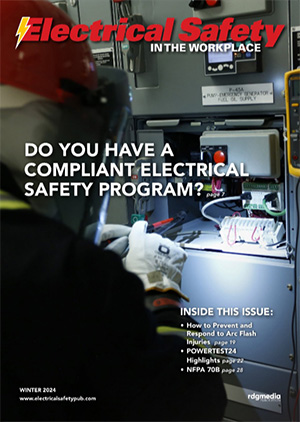Create a Safe Work Environment with Arc Flash Labeling
By Derek Vigstol, Contributor
When it comes to arc flash risk assessment, the truth is that a properly labeled environment is a safer environment than one without arc flash hazard labels. When the safety of an employee is at stake, employers can’t be over prepared. There are two options here, perform the arc flash risk assessment ahead of time and label the equipment with the results, or put the responsibility for accurately estimating the risk of injury from arc flash on the shoulders of those doing the work. However, what employers need to keep in mind is that the liability for mistakes during this risk assessment process will not ever fall on the shoulders of the one doing the work but rather will be the sole responsibility of the employer. And often, should the employee make a mistake in assessing the arc flash risk, the employer will have to explain how this individual was even qualified to do this work. The list of reasons why an employer would want to assess this complicated hazard long before an employee is in front of a given piece of electrical equipment could fill an entire article all on its own.
However, there is one specific reason that we need to focus on in particular because in all of my travels, I continue to see a lack of these important safety measures. The reason why employers should label certain equipment? It’s a requirement! As an employer, you cannot say that your electrical safety program follows NFPA 70E®: Standard for Electrical Safety in the Workplace® and then not have labels on equipment such as switchgear, panelboards, and motor control centers. Section 130.5(H) in NFPA 70E requires the owner of the electrical equipment to install and maintain labeling on equipment that portrays necessary information for employees to understand the risk that arc flash poses should they perform work when said hazard has not been reduced to a satisfactory level. However, as I mentioned, there is still a significant lack of compliance with this important requirement in NFPA 70E.
How can this deficiency in safety be fixed? We have tried education and awareness, but the needle still has a lot of room for movement and improvement. Many employers view the label required in NFPA 70E as being optional since there is not an entity that forces compliance, such as an electrical inspector will force compliance with the National Electrical Code®. In fact, a former employer of mine did not have arc flash risk assessment labels on any of the equipment within the office building they owned. When I asked why, the building management supervisor said because the 70E labels were not required like the labels in section 110.16 of the NEC®. My response to him was that maybe they should be, and it looks like someone was listening that day.
Revising Safety Requirements
The revision cycle for the 2023 National Electrical Code is nearing completion and there is one important change that took aim at increasing the number of facilities with arc flash risk assessment labels. Section 110.16(B) in the 2020 NEC required 1200A and larger service equipment in other than dwelling units to be labeled with nominal voltage, available fault current, clearing time of service OCPD, and the date the label was applied. The 2023 NEC is expanding this requirement to include feeder supplied equipment as well and the 1200A mark is reducing to 1000A. Those two changes alone are a major step forward for safety. However, Code Making Panel 1 didn’t stop there.
The 2020 label only supplied the basic information for the risk assessor to apply the concepts of NFPA 70E, with an exception that allowed labels in accordance with acceptable industry practice to be installed instead. So, what is acceptable industry practice for an arc flash risk assessment label? You guessed it, section 130.5(H) from NFPA 70E. The 2023 revision will now require a label in accordance with this acceptable industry practice. The exception has become the rule.
So, to summarize this revision as to what the 2023 NEC will require, electrical equipment supplied by circuits rated 1000A or more that is likely to require examination, adjustment, servicing, or maintenance will be required, at the time of installation, to be labeled in accordance with applicable industry practice. If we view NFPA 70E as this “applicable industry practice” then the label will require the nominal system voltage, arc flash boundary, and the necessary information to properly select needed PPE either using incident energy analysis or the PPE Category Method. This label is also required to contain the date that the label was applied to the equipment and meet the requirements of NEC section 110.21(B).
This is HUGE! The NEC has dabbled in requiring certain improvements in workplace safety related to arc flash in the past, sections 240.67 & 240.87 both require methods to reduce the clearing time of large overcurrent protective devices during faults. But this is a direct nod to requiring arc flash risk assessment as an installation practice and not leaving it up to the equipment owner to handle after the fact. However, what are the implications of this change for those tasked with turning the words on paper in the NEC into our safe built environment? This requires a little deeper dive into what significance this holds. So, join me for part two of this topic when we look at what this means for the installer and equipment owner up front. ESW
Derek Vigstol is an electrical safety consultant for E-Hazard and co-host of E-Hazard’s electrical safety podcast, “Plugged Into Safety.” E-Hazard is the industry leading provider of electrical safety consulting & training services (www.e-hazard.com).
Share on Socials!
Six Keys to NFPA 70E® Training
Risk Management in Electrical Utilities: How to Boost Operational Resilience and Respond to Emergencies
Utility Training & Awareness
Leaders in Electrical Safety
• Aramark
• Bowtie Engineering
• Enespro
• Ericson
• I-Gard Corporation
• IRISS
• KERMEL, INC.
• Lakeland Industries
• MELTRIC Corporation
• National Safety Apparel
• National Technology Transfer
• Oberon
• Saf-T-Gard
• SEAM Group
Subscribe!
Sign up to receive our industry publications for FREE!







